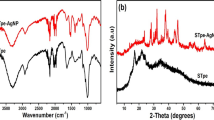Abstract
Aromatic amino acid or primary aliphatic acid available on Prunus armeniaca seed coat (PASC) powder is modified (MPASC) using thioglycolic acid and 1-ethyl-3-(3-dimethylaminopropyl) carbodiimide hydrochloride (EDC) in the form of N-substituted 2-sulfanylacetamide derivative. Infrared (FTIR), scanning electron microscopy, EDX, and XRD techniques are used for characterization of PASC and MPASC. Synthesized material is identified by the change in peak position and deformation of N–H bending vibration of primary amines peak. Peak at 1601 cm–1 due to N–H bending vibration is deformed at1656 cm–1 due to change of the primary amine into amide by thioglycolic acid. Both PASC and MPASC are then utilized for removal of As(III) form water. Adsorption experiments were conducted at different values of adsorbent dose, contact time and pH values in order to study their influence on the uptake of arsenic by the PASC and MPASC adsorbents. The Langmuir maximum adsorption capacity for PASC and MPASC were found to be 125 and 142.85 mg/g respectively. Sulfhydryl groups on MPASC indicate high affinity for As(III) ions.








Similar content being viewed by others
Change history
21 June 2023
An Erratum to this paper has been published: https://doi.org/10.1134/S1070427222100184
REFERENCES
Bangaraiah, P. and Kumar, A., IJRTE, 2019, vol. 8, pp. 2277–3878. https://www.ijrte.org/wp-content/uploads/papers/v8i4/D7634118419.pdf. https://doi.org/10.35940/ijrte.D7634.118419
Abeer, N., Khan, S.A., Muhammad, S., Rasool, A., and Ahmad, I., Environmental Technology and Innovation, 2020, vol. 20, ID 101171. https://doi.org/10.1016/j.eti.2020.101171
Sogaard, E., Chemistry of Advanced Environmental Purification Processes of Water: Fundamentals and Applications, 1st ed., 2014.
Sorg, T.J., Chen, A.S., and Wang, L., Water Research, 2014, vol. 48, pp. 156–169. https://doi.org/10.1016/j.watres.2013.09.016
Hua, J., Journal of Environmental Chemical Engineering, 2018, vol. 6, no. 1, pp. 156–168. https://doi.org/10.1016/j.jece.2017.11.062
Singh, R., Singh, S., Parihar, P., Singh, V.P., and Prasad, S.M., Ecotoxicology and Environmental Safety, 2015, vol. 112, pp. 247–270. https://doi.org/10.1016/j.ecoenv.2014.10.009
Huq, M.E., Fahad, S., Shao, Z., Sarven, M.S., Al-Huqail, A.A., Siddiqui, M.H., Habib ur Rahman, M., Khan, I.A., Alam, M., Saeed, M., Rauf, A., Basir, A., Jamal, Y., and Khan, S.U., Journal of Environmental Management, 2019, vol. 242, pp. 199–209. https://doi.org/10.1016/j.jenvman.2019.04.086
Mohan, D. and Pittman Jr, C.U., Journal of Hazardous Materials, 2007, vol. 142(1–2), pp. 1–53. https://doi.org/10.1016/j.jhazmat.2007.01.006
Shakoor, M.B., Niazi, N.K., Bibi, I., Murtaza, G., Kunhikrishnan, A., Seshadri, B., Shahid, M., Ali, S., Bolan, N.S., Ok, Y.S., and Abid, M., Critical Reviews in Environmental Science and Technology, 2016, vol. 46(5), pp. 467–499. https://doi.org/10.1080/10643389.2015.1109910
Shakoor, M.B., Niazi, N.K., Bibi, I., Shahid, M., Saqib, Z.A., Nawaz, M.F., Shaheen, S.M., Wang, H., Tsang, D.C., Bundschuh, J., and Ok, Y.S., Environment International, 2019, vol. 123, pp. 567–579. https://doi.org/10.1016/j.envint.2018.12.049
Raj, V., Jain, A., and Chaudhary, J., Journal of Pharmacy Research, 2012, vol. 5, no. 8, pp. 3964–3966.
Rai, I., Bachheti, R.K., Saini, C.K., Joshi, A., and Satyan, R.S., Oriental Pharmacy and Experimental Medicine, 2015, vol. 16, no. 1, pp. 1–15. https://doi.org/10.1007/s13596-015-0215-5
Corbett, D., Kohan, N., Machado, G., **g, C., Nagardeolekar, A., and Bujanovic, B., Energies, 2015, vol. 8, no. 9, pp. 9640–9654. https://doi.org/10.3390/en8099640
Sharma, S., Satpathy, G., and Gupta, R.K., Journal of Pharmacognosy and Phytochemistry, 2014, vol. 3, no. 3, pp. 23–28. https://www.phytojournal.com/archives/2014/vol3issue3/PartA/33.1.pdf.
Erdogan-Orhan, I., and Kartal, M., Food Research International, 2011, vol. 44, no. 5, pp. 1238–1243. https://doi.org/10.15835/buasvmcn-fst:11425
Chen, K., Zhang, Z., **a, K., Zhou, X., Guo, Y., and Huang, T., ACS Omega, 2019, vol. 4, no. 5, pp. 8568–8579. https://doi.org/10.1021/acsomega.9b00572
Nikic, J., Tubic, A., Watson, M., Maletic, S., Solic, M., Majkic, T., and Agbaba, J., Water, 2019, vol. 11, no. 12, p. 2520. https://doi.org/10.3390/w11122520
Zhang, J., Ding, T., Zhang, Z., Xu, L., and Zhang, C., PLOS ONE, 2015, vol. 10, no. 4, pp. 1–18. https://doi.org/10.1371/journal.pone.0123266
Shen, Y., Jiang, N., Liu, S., Zheng, C., Wang, X., Huang, T., Guo, Y., and Bai, R., Journal of Environmental Chemical Engineering, 2018, vol. 6, no. 4, pp. 5420–5433. https://doi.org/10.1016/j.jece.2018.08.030
Papaleo, R.M., Hallen, A., Sundqvist, B.U.R., Farenzena, L., Livi, R.P., de Araujo, M.A., and Johnson, R.E., Phys. Rev. B, 1996, vol. 5, pp. 2303–2313. https://doi.org/10.1103/PhysRevB.53.2303
Ouellette, R.J., Rawn, D., Organic Chemistry Structure, Mechanism, and Synthesis, 1st ed, Amsterdam: Elsevier, 2014.
Ghosh, S.K., Advanced General Organic Chemistry—a Modernapproach. UV–Visible and IR spectroscopy, 2nd ed., Kolkata: New Central Book Agency, 2006.
Gogoi, P., Das, M., Begum, P., and Maji, T.K., Journal of Water and Health, 2021, vol. 19(2), pp. 336–350. https://doi.org/10.2166/wh.2021.267
Wang, X., Guo, Y., Yang, L., Han, M., Zhao, J., and Cheng, X., J. Environ. Anal. Toxicol, 2012, vol. 2(7), pp. 154–158. https://doi.org/10.4172/2161-0525.1000154
Isokoski, K , Poteet, C.A., and Linnartz, H., Astronomy and Astrophysics, 2013, vol. 555, A85, pp. 1–6. https://doi.org/10.1051/0004-6361/201321517
Kumar, R., Chawla, J., and Kaur, I., Journal of Water and Health, 2015, vol. 13, no. 1, pp. 18–33. https://doi.org/10.2166/wh.2014.024
Mustapha, S., Shuaib, D.T., Ndamitso, M.M., Etsuyankpa, M.B., Sumaila, A., Mohammed, U.M., and Nasirudeen, M.B., Applied Water Science, 2019, vol. 9, no. 6. https://doi.org/10.1007/s13201-019-1021-x
Mandal, S., Sahu, M.K., and Patel, R.K., Water Resources and Industry, 2013, vol. 4, pp. 51–67. https://doi.org/10.1016/j.wri.2013.09.003
Lata, S., Singh, P.K., and Samadder, S.R., International Journal of Environmental Science and Technology, 2015, vol. 12, pp. 1461–1478. https://doi.org/10.1007/s13762-014-0714-9
ACKNOWLEDGMENTS
This work was supported by management of Manav Rachna International Institute of Research and Studies (MRIIRS) Faridabad, Haryana, India.
Author information
Authors and Affiliations
Corresponding author
Ethics declarations
The authors declare no conflict of interest requiring disclosure in this article.
Supplementary information
Rights and permissions
About this article
Cite this article
Nayyar, M., Chawla, J. & Kumar, R. N-Substituted 2-Sulfanylacetamide Prunus armeniaca: Synthesis, Characterization, and Adsorption Studies for As(III) Remediation. Russ J Appl Chem 95, 742–755 (2022). https://doi.org/10.1134/S1070427222050159
Received:
Revised:
Accepted:
Published:
Issue Date:
DOI: https://doi.org/10.1134/S1070427222050159




